The What If…? brand is the ultimate cheat code in the Marvel Cinematic Universe. Because everything takes place in an alternate dimension, literally anything can happen and it can simultaneously be part of the MCU or not. The same goes for What If…?: An Immersive Story, which is now available for Apple Vision Pro. It introduces several characters you know and love but presents them in all new ways.
So, how did that come about? And does the end of the story mean anything going forward? io9 spoke with two of the people responsible for the part-VR, part-AR experience to find that out and a whole lot more.
io9 spoke with Dave Bushore, director and executive producer at Marvel Studios, and Shereif M. Fattouh, executive producer at ILM Immersive, about the latest Marvel release. Using full spoilers from the hour-long game, we dove into why this experience exists at all, why it ended up on Apple Vision Pro, and if some late game choices directly impact the next installment in the MCU, Deadpool & Wolverine.
Whether you have an Apple Vision Pro and plan on playing, or don’t and can’t, just beware, there are major spoilers for the experience below.
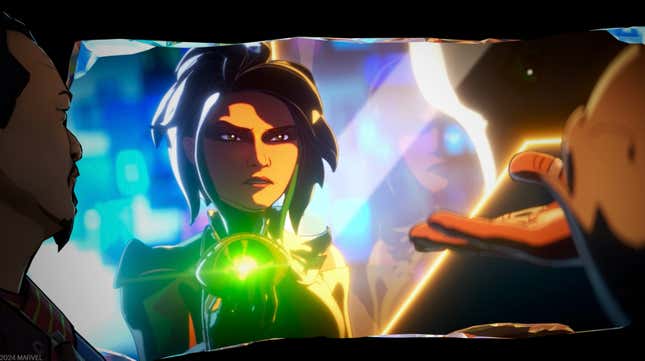
This interview has been edited for length and clarity.
What If…?: A Marvel Experience makes the player the next hero of the multiverse. With the help of Wong, and under the guidance of the Watcher, you travel across the galaxy collecting Infinity Stones. You first get one from Thanos on Titan, with the help of Carol Danvers. Next, you get one from a mysteriously veiled version of Captain America in Siberia, with the help of the Red Guardian. Then, you get one from the Collector with Hela’s help on Nowhere.
What is revealed eventually though is that it was not the Watcher helping you, it was Wanda Maximoff posing as him, and you must fight with your multiversal allies to defeat her. Vision intervenes too.
We mention all that because, when asking about the impetus behind creating this whole new experience, the plights of those characters—specifically Wanda and Vision—were at the forefront.
Dave Bushore, director and executive producer at Marvel Studios: The What If…? of it all was obviously the jumping-off point, but then it was what can we learn differently in this experience that is iconic, fun, cool, different, and how can we add some emotionality? And when I say “some emotionality,” I mean: how can we put a different context of emotion around the characters that we’re working with? For me specifically … that was Wanda and Vision. To me, that was the jumping-off point because inside of What If…? you can do whatever you want. I love them as characters, but also that they’ve never gotten their happy ending—and the idea of being able to develop a story that sits inside of a new piece of technology, where you are the protagonist, where you are playing along, and playing a central role in all of these characters journeys, that you get to be the one to give them their happy ending was the biggest, most fun part of developing the story because it’s so emotional for both of them. And the idea that we could actually bring that to life authentically in a way that makes people go, “Wow, I’m feeling something about these two characters right now, and I played a role in that” is amazing.
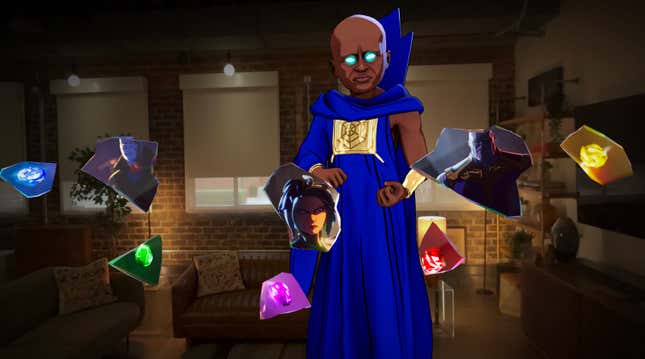
But then it was also, you look at Thanos. I love Thanos as a character because I think he is what a lot of people have to go through, which is be strong “because.” And you look at that guy and you go, “But what if he’s being strong for a reason that’s actually trying to do the right thing?” He’s taking an Infinity Stone because he’s actually trying to save his planet and save his people. And you look at the human side of these characters and what it means and the choices that they face, and apply that to all of them.
Shereif M. Fattouh, executive producer at ILM Immersive: What’s awesome with Dave, Marvel, and especially with the What If…? series was a real desire to tell an authentic story. And when we got the first script treatments back, there was a depth to it. With these characters, we could [explore] mature themes, like Hela—she’s learning to let go of the whole dilemma with Fenris. .. expectations of her father on her that was touched on in season two, but then also this thing of, can you learn to say goodbye or are you going to cling on to it? That’s a human condition we’ve all faced. And again, like we mentioned with Thanos, what if circumstances were different [and] he did become the leader, not in a homicidal way, but in a way that could actually achieve his goals?
It was so fun that we didn’t have to dumb it down, so to speak. It takes real ambition, creatively, to be like it’s new, it’s wild, it’s insane with all this technology. But that doesn’t mean it can’t be a complex and rich story. And that was one of the things we want to do is be authentic to [What If…?]. We see these themes in the actual series. We see this in the MCU all the time. It was a real privilege to have that same thoughtfulness in the actual storylines and the plot and the characters, that wasn’t just “Shoot, blast, block,” move on to the next level.
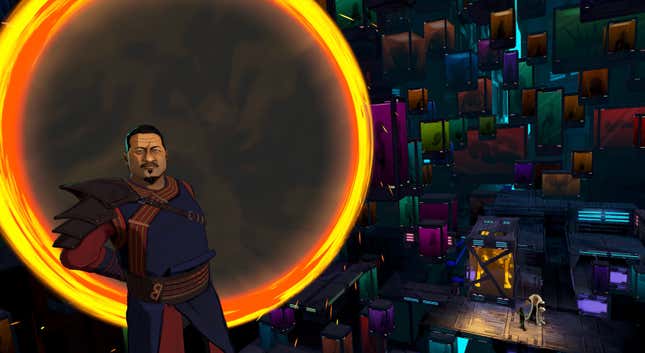
One of the biggest barriers to more people being able to play in this world is that it’s, for now, exclusively on the Apple Vision Pro. We asked how that happened, what are the pluses to it, and the team’s feelings on its scope being limited due to the hardware.
Fattouh: ILM has been doing this for a long time, [always] trying to be on the cutting edge of what’s there and developing for what’s possible in this space. We’re really focused on pushing storytelling and technology forward. So really, the thing that I think stood out the most to all of us when we saw [Apple Vision Pro] for the first time was the clarity of the pass-through. Being able to really detect your hands. Not having controllers. We’d been thinking about that before it was manifested. We knew these kind of innovations were coming. But really that magic of seeing your real-world hands comped even inside of VR? We hadn’t seen that before to that level of accuracy where it’s like literally your hand is cut out, but it’s not like a controller and it’s not like some virtual weird thing. It’s your actual hand. From a storytelling standpoint that technology allows us to tell this unique story that really fit in the fiction. So we were really focused on maximizing like, “Okay, this is an amazing piece of hardware. What can we do to really push it at every level?”
Bushore: From a storytelling standpoint and from a Marvel standpoint, we’re just trying to tell the best story. And we knew that with Apple Vision Pro, we could tell this story authentically and it would feel authentic to What If…? Our starting point was “As many people as possible.” We want the fans to be able to do these experiences because we’re just starting that conversation with the audience, right? We hope there are opportunities for this experience to live on and for as many people to do it in as many possible ways as are out there. But it was about the opportunity to push that conversation forward, to push the storytelling forward, to open new doors, to try new things so that as these things progress, we can bring those things authentically to life more and more and more. Our hope is that this continues to push the envelope and brings totally new ideas to the forefront. “Hey, now we can do this! Hey, now we can bring this character in and we can send you over here,” right? And we’re just at the fledgling stages of having that conversation.
So it was just about really just pushing as hard as we could to try to keep innovating the storytelling. How do we open those Marvel doors to the universe as wide as possible? Because I think all we did was kick it open. This is just “We kicked it open,” and now it’s, “How much can we pull from 80 years of storytelling, character development, the things that people love and bring them to them in an entirely new way?” Because the thing this piece of technology does is … it forces you to be present with the characters in a way that you’ve never been able to do before. That’s why we want as many people to be able to do it as possible because you can’t be on your phone. You have to be there in the story. And so just thinking about that opportunity for other characters and other things was really the reason to push it forward.
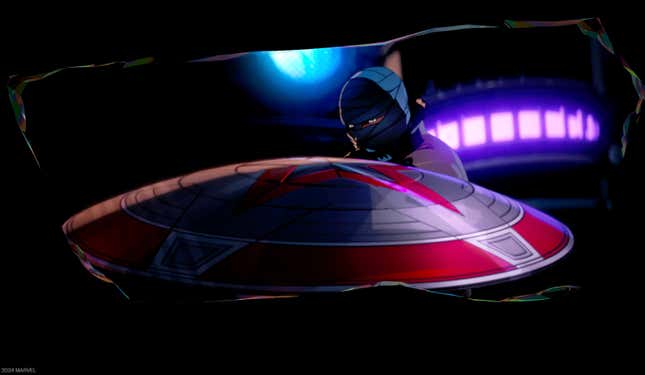
Near the end of What If…? You’re presented with a choice: keep the Infinity Stones for yourself and start a new timeline or destroy the stones and save the multiverse. Whatever you choose, if you’ve seen the movies, you know exactly how to do it and here we dove into each choice.
Bushore: We’ve always wanted to do the snap moment. As soon as we started talking about Infinity Stones, it was, “Well, we have to do the snap moment.” What ILM did in terms of bringing that gesture to life in this moment and “Boom!” It feels authentic and it literally feels like “Well, I’ve seen that. But I’m living it now.” That was awesome.
So it was definitely a cognitive effort to say, “What do those choices mean?” Destroying the stones or keeping the stones. It was trying to keep it open-ended to say a little bit of you can see the ramifications of making one decision or the other. Like when you create a new timeline, Miss Minutes comes in and goes, “Hey, that wasn’t the best idea ever.” But there is some fun attached to it, which is “Well, now you’re going to go on this other adventure,” right? Did you just screw up everything? Maybe. Maybe we’ll find out later
The idea of destroying the stones was giving some semblance of doing the right thing is the right thing. And seeing the characters progress in that way, seeing Thanos actually lead the people of Titan to a new world, seeing Hela be able to let go of her past and then also being recruited as a hero by Captain Carter, it gave us some opportunity to do something we had talked about from the beginning, which is: what’s your reward for each one of those choices?
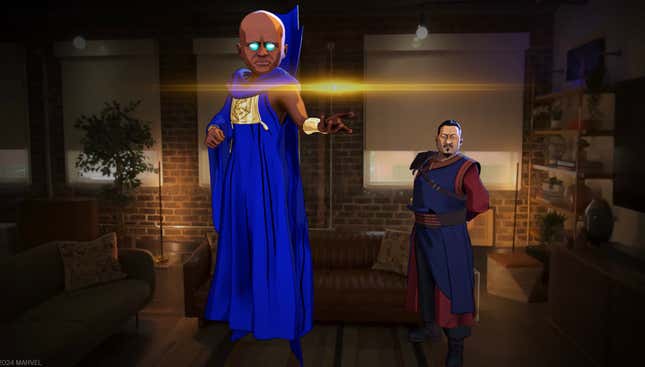
So what are the rewards? If you choose to destroy the stones, you are recruited by Captain Carter to join the Guardians of the Multiverse and get your very own Cap shield. If you keep the stones and create a new timeline, not only does Miss Minutes visit you, but she tells you you have to team up with someone else to fix it—and we see footage from Deadpool and Wolverine. As I was playing, my mind immediately went to the possibility that my choice started the events of that film. Marvel doesn’t 100% confirm that.
Bushore: That’s the fun of it, right? We didn’t want to put a hard answer on it, because the fun of it is, “Well, if I make those decisions, those are your internal thoughts and your choices and you’re the only one that knows.”
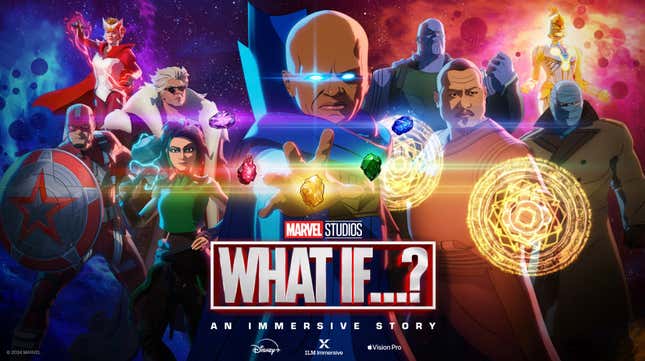
Whether you choose to keep the stones and see Miss Minutes and Deadpool, or destroy the stones and team up with Peggy Carter, either choice seems like it could be a good jumping off point for another story. We asked if that was the plan.
Bushore: There are definitely places we can go … A long time ago, [we were] talking about Miss Minutes originally as a jumping-off point for anything AR because obviously, she’s perfect for this type of thing.
Fattouh: She is AR.
Bushore: Right. The idea of actually going through a time door anywhere you wanted. The idea of what Loki and the TVA have set up, and now with the expansion of what Deadpool and that film will bring to the possibilities of being able to live in that space, I think is fun. I would love to explore the whole idea of the TVA more and what Loki is. We obviously have Easter eggs in the experience [about that]. And then the Guardians of the Multiverse, right? I mean, who do you get to team up with? What could that be in the future? I mean, those are, yes, of course, huge and incredibly fun possibilities.
What If…?: An Immersive Story is now out exclusively for Apple Vision Pro. Learn more at Marvel.com/WhatIfImmersive or ILMImmersive.com/WhatIfImmersive.
Want more io9 news? Check out when to expect the latest Marvel, Star Wars, and Star Trek releases, what’s next for the DC Universe on film and TV, and everything you need to know about the future of Doctor Who.
Trending Products

Cooler Master MasterBox Q300L Micro-ATX Tower with Magnetic Design Dust Filter, Transparent Acrylic Side Panel…

ASUS TUF Gaming GT301 ZAKU II Edition ATX mid-Tower Compact case with Tempered Glass Side Panel, Honeycomb Front Panel…

ASUS TUF Gaming GT501 Mid-Tower Computer Case for up to EATX Motherboards with USB 3.0 Front Panel Cases GT501/GRY/WITH…

be quiet! Pure Base 500DX Black, Mid Tower ATX case, ARGB, 3 pre-installed Pure Wings 2, BGW37, tempered glass window

ASUS ROG Strix Helios GX601 White Edition RGB Mid-Tower Computer Case for ATX/EATX Motherboards with tempered glass…










